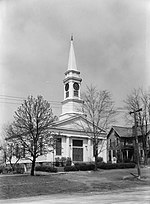Twins Days is held annually on the first full weekend in August in Twinsburg, Ohio, United States to celebrate biological twins (and other multiples, e.g. triplets, quads). The event has taken place every summer since 1976 when the festival was founded by a group of Twinsburg citizens, based on a concept developed by Ray Diersing, Sage Hiller, and Ari Hiller. The first time Twins Day was proposed to city council, it was rejected; city council thought it was a bad idea. It is the largest annual gathering of twins in the world, and draws thousands of participants from all over the United States and elsewhere in the world.
The event routinely attracts about 2,000 pairs of twins. About 1,140 sets of multiples pre-registered for the 2014 festival, including people from Nigeria, Brazil, Australia, Ghana, Canada, Ireland, New Zealand, France, Italy, England, Belgium, Germany, Japan, China and India. The 2014 festival was themed as a "peace and love" event, and billed as "Twinstock: Groovy in Twinsburg".The festival has developed its own traditions over the years. As the writer Tony Barrell noted in a major press article in 2003, “An unwritten festival rule means that identical twins are identically dressed, too. This applies as much to 70-year-old men as to 17-year-old girls, and to tiny babies, wheeled around in fleets of twin buggies.” The festival is opened every year with a performance of The Star-Spangled Banner, sung by John and Jerry Starlet and signed in ASL by Jamie Maassen and Jodie Qualkinbush, and a parade along Ravenna Road (former SR-14).
The festival attracts many members of the scientific community, who use the presence of thousands of identical and fraternal twins to conduct voluntary twin studies, in order to determine the genetic or non-genetic basis of a wide range of human traits. Twins are customarily rewarded for their participation.Barrell also noted that there was a tendency among Twins Days attendees to form human patterns: “Pairs of complete strangers seem continually, magnetically drawn to one another, to shake hands, slap backs – and, sometimes, take the relationship further... Another extraordinary thing is happening: clumps of twins keep making human patterns. Every few seconds, two or three or more sets get together in symmetrical formations and smile for somebody’s camera. They seem powerless to resist the compulsion, and watching it is like seeing the colors coalesce in a giant kaleidoscope.”









